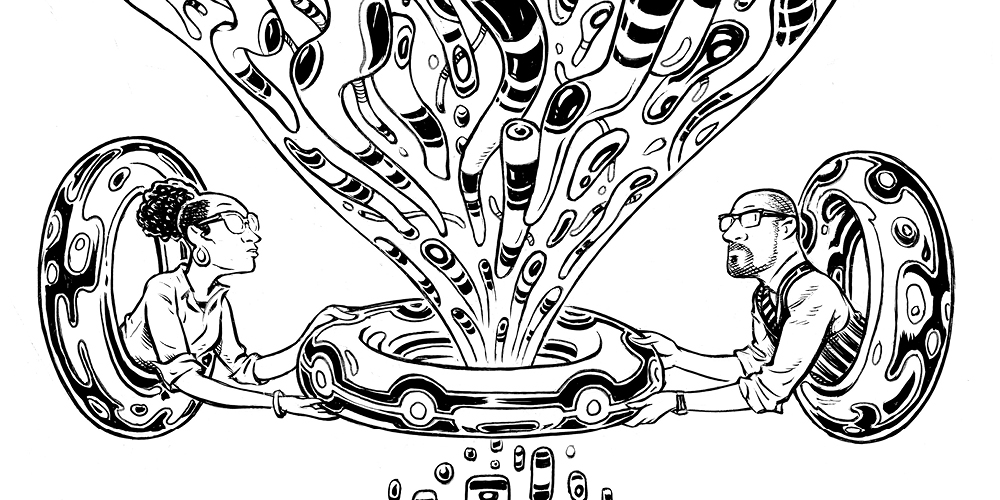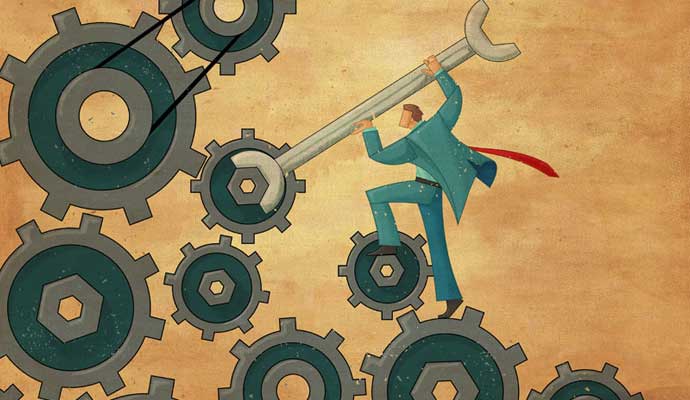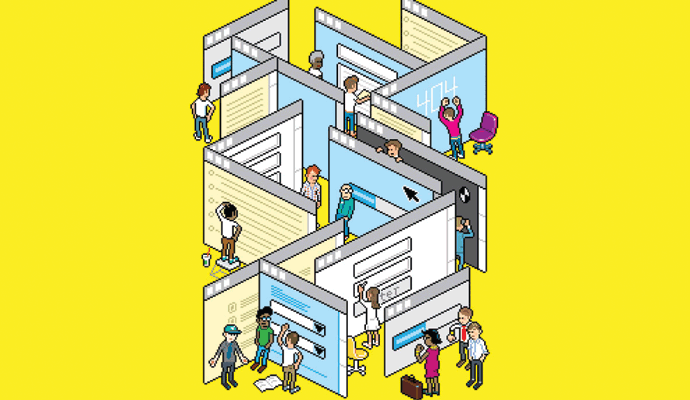Why you should apply design thinking to the employee experience
COVID-19 has forced changes in the way people work — and created a once-in-a-generation opportunity to increase engagement and productivity.
A version of this article appeared in the Spring 2021 issue of strategy+business.
The tools of talent management — hiring, on-boarding, performance reviews — are changing, some for now, others for good. Teamwork, collaboration, and tacit knowledge-sharing have also been disrupted. The mere fact that many people are separated from friends and colleagues, which can strain their relationships, is a big deal: Affirmative answers to the question “Do you have a best friend at work?” consistently correlate with higher employee retention, better customer metrics, increased productivity, and greater profitability, according to Gallup.
Quite simply, work is different today. The COVID-19 pandemic has upended workplace routines and destroyed norms. Team rooms have become Zoom rooms. Gone are the informal chats in the hallway or by the coffee machine. Bullpens and hoteling designs are out, private offices are in, off-sites are over, and business travel has gone bust. Many people will work from home much or all of the time for the foreseeable future. For the jobs in which this is not possible, employees are working split shifts and companies are redesigning work teams and work spaces to make health and safety easier to manage.
Amid all these changes, what’s too often missing is an overarching plan to design a better employee experience. That broad term encompasses daily activity (what it’s like to work somewhere), productivity (getting things done), values and culture (what makes work meaningful), and career (learning, advancing, growing). In our previous strategy+business article, we wrote about how businesses should rethink their customer experience in the age of COVID-19. But these turbulent times also represent a great opportunity to redesign — or, in some cases, do a first design of — the employee experience. Indeed, the two go hand in hand: In an economy increasingly dominated by services, employee experience and customer experience are inextricably linked.
Moreover, study after study shows that a superior employee experience confers business benefits, just as an excellent customer experience does. Attraction, retention, engagement, productivity, and profit all rise as employee experience improves. In the Thrive XM Index, which ranks companies by “employee well-being,” companies that placed in the top 10 percent outperformed peers in the Fortune 500 by EBITDA margin and return on equity in the second quarter of 2020.
Designing the employee experience goes beyond figuring out how to make remote work possible and palatable or how to make work sites safer. So how do company leaders create the magic? The design-thinking mindset and tool kit that produce better customer experience can do the same for employees. We’ll draw on what we call the SPICE (segments, promises, innovation, coherence, and efficiency) principles to demonstrate how companies can attract and keep good people, help them do their jobs better, and ensure that their behavior aligns with the company’s value proposition — all of which will help restart growth and restore profits.
Segments: Find and keep the right employees by redesigning talent planning. In many companies, talent planning — strategy, hiring, training, assessment — is reactive, taking place after business unit plans and budgets are completed. This year, don’t wait. Asking who your “right” employee is has become as important as asking who your “right” customer is, because the answer might have changed in several respects.
For example, you may need employees with different skills, and you must consider whether those new skills will be needed only in the short term or will be part of a permanent change. The outgoing, bubbly person who staffed an in-person retail environment may be less critical now than a tech-savvy introvert who can run A/B tests on your website all day long. You may need to recruit from a variety of talent pools and deliver training through new channels. If you have a high-potentials program, it will have to be redesigned. Supervisors will require new tools and new coaching.
Also important: You might need to evaluate whether your best people — folks who get your values and have the skills central to your value proposition — are struggling, and how to help them if they are. We talked to a partner in a Philadelphia-area law firm who said his firm’s associates and researchers weren’t faring as well with a work-from-home arrangement as the partners were, possibly because the junior staff relied more heavily on one another for informal collaboration and learning than seasoned staff did.
His immediate solution was to get people back to the office. But that was a patch, not a fix. Imposed from the top, it didn’t recognize some employees’ practical problems with working at the office (parents of young children attending school in a virtual or hybrid model, for example) or the anxiety others might have. What was really needed was a rethink and redesign of the learning-by-doing model that professional-services firms rely on to develop the next generation of partners.
Promises: Reset your expectations of employees and their expectations of you. A study by Ohio State University’s National Center for the Middle Market (where one of this article’s authors worked) shows that high-performing cultures have one thing in common: They highlight what employees can control and do rather than stressing what they cannot or should not do. That is, they give employees clear expectations and the power to meet them. That combination drives both productivity and satisfaction.
Job descriptions, employee handbooks, performance reviews, goals, incentive plans — all of these are part of setting expectations. So are undocumented, day-to-day routines — the behaviors shown, seen, and absorbed at work. But many traditional expectations are no longer realistic. “We’re reexamining all our job descriptions and deliverables, especially for remote workers,” says the CEO of a Kansas aerospace company. After all, you can’t expect a consistent nine-to-five workday when schools are remote or have adopted hybrid models or when workers are suddenly sidelined by sickness or the need to quarantine.
Any redesign should begin with explicit expectations. Job descriptions, for example, should focus more on outcomes than activities. Now is not the time to simply roll out last year’s performance-review templates. Numerous companies are changing the way they conduct such reviews. Among the steps some have taken: encouraging more informal and more frequent conversations between managers and employees; scrapping reviews for all or part of 2020 (Twitter is doing the former; Facebook did the latter); and looking at altering the goals and metrics against which people are judged.
But implicit promises need rethinking, too. How should mentoring happen when people aren’t together in the office? What should employees’ expectations be for career paths, promotions, and job security, when so many plans have been overturned by force majeure?
In addition, some implicit promises may need to be made explicit. In many work environments, technology and the ability to communicate 24/7 have made the barriers between work and home fuzzy. Now may be a time to set firmer barriers that allow your employees to feel they can make a mental separation between work and home, even if they can’t make a physical one. Employers that offer the highest wages, snazziest offices, or most prestige may no longer have an advantage over those that promise empathy, security, and authenticity. Cool is fine. But right now, warm may be better.
Now may be a time to set firmer barriers that allow your employees to feel they can make a mental separation between work and home, even if they can’t make a physical one.
Other promises, such as cleanliness, candor, and compliance, may become much more important. Whereas they were once considered a simple, standard part of the office experience, these elements might now be matters of life and death. “There’s still too much we don’t know about putting people back into the workplace for us to feel like we can do it responsibly,” says one chief operating officer who oversees some 130 workplaces around the country, ranging from small sites in strip malls to multiple floors in metropolitan skyscrapers. Safety is both a fact and a perception: “We’ve spent literally millions of dollars to make our workplaces safe and hygienic, but I’m more worried about the optics of asking people to go back to the office,” she admits.
Transparency and honesty are more critical than ever. “People understand lack of certainty, and they’ll forgive that,” says one workplace consultant. “What they won’t forgive is dodging the issue, fudging the truth, or ignoring people’s concerns.” Some large employers — Ohio State is one — maintain COVID-19 dashboards of key health statistics. They’re not unlike the visual control dashboards familiar to managers and staff at well-run factories.
Innovation: Experiment, experiment, experiment — then capture what you learn. Policies and processes can all get stale. Companies that were steadfast in the belief and practice that employees had to work from the office were forced to abandon that conviction abruptly. It seems that after bumps and starts, many are pleasantly surprised at how well remote work is going and are considering sticking with it for longer than they’d originally planned. What’s important here is not that companies went remote — after all, that was a matter of necessity. What’s important is for them to figure out why it’s working and use the example as a rationale for examining other articles of faith.
Some might argue that this is the wrong time to try new things, given the day-to-day stress people are experiencing. In fact, it’s an ideal time. Says Keith Ferrazzi, a leadership and organizational coach, “We shouldn’t be talking just about how to get people back to the office, or just about how to make work-from-home productive. We should be rethinking how to do the work and involving employees in the process.” Study the improvisations and work-arounds your employees have been using. What’s working for them? For you? What should be scaled up?
Consider self-management: For 70 years, researchers have known that self-managed teams often do better work than closely supervised ones; COVID-19 might do more to expand the practice than anything else has. Last year, Walmart tried out a new structure at Sam’s Club and Walmart Neighborhood Markets that involved cross-training teams and making them responsible for managing stock and keeping shelves looking good, according to Dacona Smith, chief operating officer at Walmart U.S., in an interview with the Detroit News.
Now, Smith went on, Walmart supercenters will be rolling out a similar structure. He expects both productivity and employee experience to benefit. “Through this new, tiered structure for team leads, we’re creating room for pay and career growth while investing in areas like pickup and delivery as customers increasingly turn to those options,” Smith said. The move speaks to the importance of innovation for both customers and employees, and the symbiotic nature of customer experience and employee experience.
Keeping things as they are for the sake of it is pointless; so is innovation without a good reason. Make the distinction between improvisation — what you’ve been forced to do by circumstance, making it up as you go along — and thoughtful change. Solicit feedback widely and have some method for capturing and assessing it.
Coherence: Make sure that employees see how their work fits into the larger picture, and that they all feel they are working for the same company. Boundaries, silos, and bungled handoffs are not only a problem for customers; they upset employees, too. They make for duplicative work, increase the chance for error, and make employees feel alienated and unappreciated. Often the problem is siloed information. For example, a survey by PrecisionLender, which makes software that helps bankers price loans, found that 46 percent of bankers believe they don’t have full visibility into a customer relationship when making a loan decision.
The pandemic has revealed and exacerbated many companies’ lack of coherence. The exigencies of managing remote work have revealed instance after instance of weak process design. Before COVID-19, it was possible to cover up for poor processes or lack of knowledge-sharing by running down the hall to get the answer to a question. Now, having to do the equivalent remotely or when work schedules are uncertain is exponentially more difficult.
Tools such as customer journey maps can be turned inward to chart the steps employees take to get work done: who assigns them work, what tools and resources they need, whom they hand work off to. You can also use process maps, which more typically measure the flow of material or paperwork, to show what people have to do at each point in a process. Like customers on the outside, “internal customers” have changed today. This is a good time to write (or rewrite) service-level agreements between business units and functions such as IT, human resources, and finance — again, involving employees in the process.
Using traditional customer journey tools can also reveal any cultural dissonance in the company. Nobody expects the communications team and the compliance team to function exactly the same way in a financial-services firm, for example, but people from different departments shouldn’t feel as though they work at different companies. “When people are working across departments, disparities in attitude, focus, and approach can create a range of problems, from unnecessarily prolonging projects to resentment,” notes a former chief risk officer at a health insurer. “If these disparities aren’t addressed, the teams won’t be able to work together any better in the future.”
Efficiency: Make it easier for employees to do their jobs. Work is more satisfying when it is less of a hassle. Efficiency isn’t just about time; it’s about time well spent. Is it easy for people to do their jobs? If not, what is getting in the way? In a pre-pandemic Qualtrics survey, employees cited inefficient processes as the number one obstacle to their productivity. The pandemic has added to the burden, sometimes in an unexpected manner. “Working from home is great in lots of ways,” a financial planner told us, “but my work space is less efficient, I haven’t got all the tools I’m used to, the VPN is slow, and tech support is a pain.”
There have been conflicting studies about pandemic productivity among the workforce, with some showing it increasing and some the opposite. But the real point isn’t productivity as measured in output per hour; it’s whether the work arrangements and the workplace design — virtual or not — make it harder or easier for employees to do their job.
Enhance the employee experience by making sure employees have not only the right tools and equipment but also the right information, the right level of empowerment, and the right access to colleagues and higher authority. Many companies conduct annual employee engagement or satisfaction surveys. Our advice: Throw them out, at least for now.
What you need now is a steady series of short pulse surveys and conversations that ask employees to name their three biggest time wasters or other headaches. Focus on tools (“Do you have what you need?”), authority (“Are you empowered to make decisions?” or “Is it easy to get approvals?”), and distractions (“What pulls you away from the task at hand?”). Turn those answers into a Pareto chart, start working the list, and come back the following month to get new insights.
Just as you can’t improve customer experience by holding “customer-centricity week” rallies, you can’t strengthen employee experience with a series of sympathetic emails. A better experience is the result of a coordinated set of thoughtful, intentional actions. A positive employee experience enables your people to do a good job and helps them feel that they have a good job. Should it have taken a crisis like COVID-19 to make companies aware of this? No, but the pandemic has created an imperative that companies literally can’t afford to ignore.







